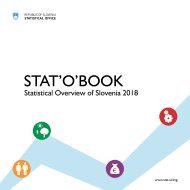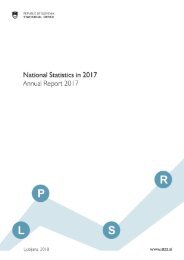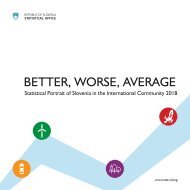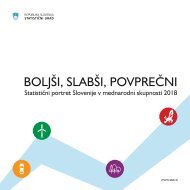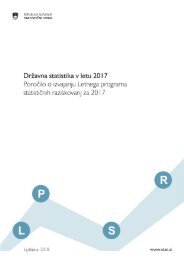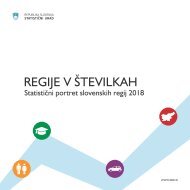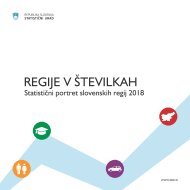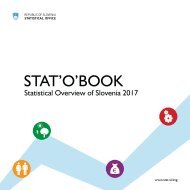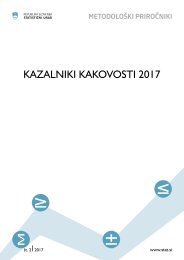quality-indicators-2017
Create successful ePaper yourself
Turn your PDF publications into a flip-book with our unique Google optimized e-Paper software.
QUALITY INDICATORS <strong>2017</strong><br />
The value of indicator T1 can be presented in different forms; for this purpose the standard error, the coefficient<br />
of variation and the confidence interval are most frequently used.<br />
The standard error of the estimate is equal to the square root of the sampling error, i.e.:<br />
se( Y<br />
ˆ<br />
) Var ˆ ( Y<br />
ˆ<br />
)<br />
.<br />
The coefficient of variation is defined as the ratio between the standard error of the estimate and the estimate<br />
itself:<br />
se(<br />
Y<br />
ˆ<br />
)<br />
cv( Y<br />
ˆ<br />
) <br />
Y<br />
ˆ<br />
.<br />
The coefficient of variation is usually expressed as a percentage.<br />
At a 95% confidence level, the lower ( I<br />
SM<br />
calculated as follows:<br />
I Y<br />
ˆ<br />
1,96 se(<br />
Y<br />
ˆ<br />
SM<br />
)<br />
,<br />
I Y<br />
ˆ<br />
1,96 se(<br />
Y<br />
ˆ<br />
ZM<br />
)<br />
.<br />
) and the upper ( I<br />
ZM<br />
) limits of the confidence interval can be further<br />
3.3.3 Explanation and calculation examples<br />
The estimation of sampling errors of statistical results is a complex and extensive problem from both theoretical<br />
and practical standpoints. The simple formulas presented in Section 3.2 only apply in simple random sampling,<br />
which is rarely used in practice. By using more complex sampling designs or more demanding (non-linear)<br />
estimators, theoretical results are much more demanding and sometimes cannot be expressed in an exact<br />
analytical form.<br />
The approaches applied to the calculation of the sampling error can be roughly divided into three groups:<br />
Analytical approach. For the calculation of the sampling error, direct or approximate formulas are used<br />
(usually on the basis of a linearisation method).<br />
Resampling approach. A set of subsamples is selected by means of an appropriate procedure; for each<br />
subsample an appropriate estimate is calculated; the variability of estimates obtained from different<br />
subsamples will then serve for the estimate of the sampling error.<br />
Appropriate model approach. The sampling error is expressed as a function of known parameters (or<br />
more easily measured parameters). These parameters may be: the estimate itself, the random error<br />
assuming simple sampling, the sampling error for the entire sample – the model provides an estimate for<br />
the domain, etc.<br />
Example: Let us say that after we have implemented a statistical survey in which the mean value of variable Y<br />
is estimated on the basis of a simple random sampling without replacement, we get the data shown in the table<br />
below:<br />
Population size<br />
( N )<br />
Sample Size ( n )<br />
Mean Estimate<br />
(Yˆ )<br />
Population Variance<br />
Estimation<br />
2<br />
( s )<br />
10,000 500 800 50,000<br />
In accordance with the above-stated formulas, we then calculate:<br />
500 50000<br />
Var ( Y<br />
ˆ<br />
) (1 ) 0.95100<br />
95<br />
10000 500<br />
se ( Y<br />
ˆ<br />
) 95 9.75<br />
12





